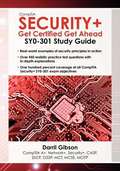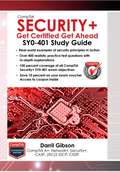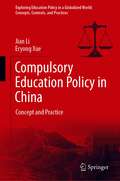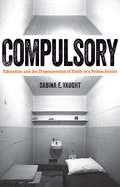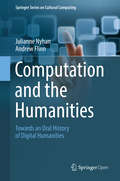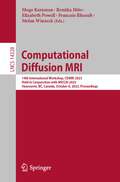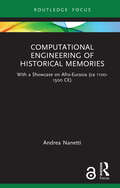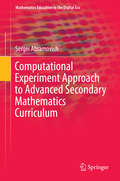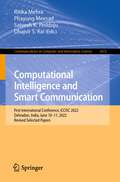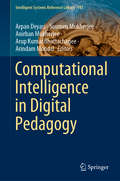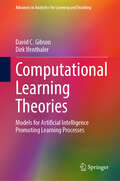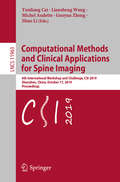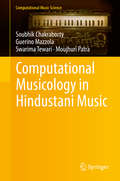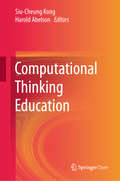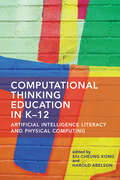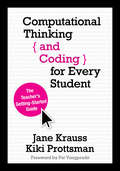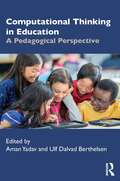- Table View
- List View
Comptia Security+: Sy0-301 Study Guide
by Darril GibsonCompTIA Security+: Get Certified Get Ahead: SY0-301 Study Guide is an update to the top-selling SY0-201 guide, which helped thousands of readers pass the exam the first time they took it. The SY0-301 version covers every aspect of the SY0-301 exam, and includes the same elements readers raved about in the previous version. Each of the eleven chapters presents topics in an easy to understand manner and includes real-world examples of security principles in action. The author uses many of the same analogies and explanations he's honed in the classroom that have helped hundreds of students master the Security+ content. You'll understand the important and relevant security topics for the Security+ exam, without being overloaded with unnecessary details. Additionally, each chapter includes a comprehensive review section to help you focus on what's important. Over 450 realistic practice test questions with in-depth explanations will help you test your comprehension and readiness for the exam. The book includes a 100 question pre-test, a 100 question post-test, and practice test questions at the end of every chapter. Each practice test question includes a detailed explanation to help you understand the content and the reasoning behind the question. You'll be ready to take and pass the exam the first time you take it. If you plan to pursue any of the advanced security certifications, this guide will also help you lay a solid foundation of security knowledge. Learn this material, and you'll be a step ahead for other exams. This SY0-301 study guide is for any IT or security professional interested in advancing in their field, and a must read for anyone striving to master the basics of IT systems security.
Comptia Security+: Sy0-401 Study Guide (Get Certified Get Ahead)
by Darril GibsonCompTIA Security+ Get Certified Get Ahead: SY0-401 Study Guide is an update to the top-selling SY0-301 guide, which helped thousands of readers pass the exam the first time they took it. The SY0-301 version covers every aspect of the SY0-301 exam, and includes the same elements readers raved about in the previous version. Each of the eleven chapters presents topics in an easy to understand manner and includes real-world examples of security principles in action. The author uses many of the same analogies and explanations he's honed in the classroom that have helped hundreds of students master the Security+ content. You'll understand the important and relevant security topics for the Security+ exam, without being overloaded with unnecessary details. Additionally, each chapter includes a comprehensive review section to help you focus on what's important. Over 400 realistic practice test questions with in-depth explanations will help you test your comprehension and readiness for the exam. The book includes a 100 question pre-test, a 100 question post-test, and practice test questions at the end of every chapter. Each practice test question includes a detailed explanation to help you understand the content and the reasoning behind the question. You'll be ready to take and pass the exam the first time you take it. If you plan to pursue any of the advanced security certifications, this guide will also help you lay a solid foundation of security knowledge. Learn this material, and you'll be a step ahead for other exams. This SY0-401 study guide is for any IT or security professional interested in advancing in their field, and a must read for anyone striving to master the basics of IT systems security. The author also posts related blogs to supplement the book at http://blogs. getcertifiedgetahead. com/.
Compulsory Education Policy in China: Concept and Practice (Exploring Education Policy in a Globalized World: Concepts, Contexts, and Practices)
by Jian Li Eryong XueThis book explores the overall landscape of compulsory education policy development in China from multiple perspectives to uncover the stages, features, problems and suggestions in Chinese compulsory education system, locally, nationally and internationally. In addition, this book also presents specific historical educational policy shifts for policymakers and stakeholders to investigate the compulsory education strategy over the long term. Specifically, the Chinese compulsory education policy landscape involves investigating changes to the legal environment, management policies, as well as practices for teachers and curriculum and teaching materials. These discussions contribute to the readers’ comprehensive and systematic understanding of compulsory education policy development in contemporary China.
Compulsory: Education and the Dispossession of Youth in a Prison School
by Sabina E. Vaught&“This is an American story, unsettled by contradictions, constituted by unresolvable loss and open-ended hope, produced through brutal exclusivities and persistent insurgencies. This is the story of Lincoln prison.&” In her Introduction, Sabina E. Vaught passionately details why the subject of prisons and prison schooling is so important. An unprecedented institutional ethnography of race and gender power in one state&’s juvenile prison school system, Compulsory will have major implications for public education everywhere.Vaught argues that through its educational apparatus, the state disproportionately removes young Black men from their homes and subjects them to the abuses of captivity. She explores the various legal and ideological forces shaping juvenile prison and prison schooling, and examines how these forces are mechanized across multiple state apparatuses, not least school. Drawing richly on ethnographic data, she tells stories that map the repression of rightless, incarcerated youth, whose state captivity is the contemporary expression of age-old practices of child removal and counterinsurgency. Through a theoretically rigorous analysis of the daily experiences of prisoners, teachers, state officials, mothers, and more, Compulsory provides vital insight into the broad compulsory systems of schooling—both Inside prison and in the world Outside—asking readers to reconsider conventional understandings of the role, purpose, and value of state schooling today.
Computation and the Humanities: Towards an Oral History of Digital Humanities (Springer Series on Cultural Computing)
by Julianne Nyhan Andrew FlinnThis book addresses the application of computing to cultural heritage and the discipline of Digital Humanities that formed around it. Digital Humanities research is transforming how the Human record can be transmitted, shaped, understood, questioned and imagined and it has been ongoing for more than 70 years. However, we have no comprehensive histories of its research trajectory or its disciplinary development. The authors make a first contribution towards remedying this by uncovering, documenting, and analysing a number of the social, intellectual and creative processes that helped to shape this research from the 1950s until the present day. By taking an oral history approach, this book explores questions like, among others, researchers' earliest memories of encountering computers and the factors that subsequently prompted them to use the computer in Humanities research. Computation and the Humanities will be an essential read for cultural and computing historians, digital humanists and those interested in developments like the digitisation of cultural heritage and artefacts. This book is open access under a CC BY-NC 2. 5 license
Computational Biology: A Hypertextbook (ASM Books)
by Dennis Didulo Scott KelleyAn introduction to the world of bioinformatics Massive increases in computing power and the ability to routinely sequence whole genomes of living organisms have begun to fundamentally alter our understanding of biology, medicine, and agriculture. At the intersection of the growing information and genomics revolutions sits bioinformatics, which uses modern computational power to reveal patterns in biological data sets, especially DNA, RNA, and protein sequences. Computational Biology: A Hypertextbook, by Scott Kelley and Dennis Didulo, provides a wonderful introduction for anyone who wants to learn the basics of bioinformatics. This book is more than a textbook because of the wealth of online ancillary materials and how the print and electronic components are integrated to form a complete educational resource. Aspects that make Computational Biology: A Hypertextbook a unique and valuable tool for teaching and learning bioinformatics include Clear explanations of the basic biology of DNA, RNA, and proteins and how the related bioinformatics algorithms work Extensive exercises that enable students to practice with the same bioinformatics applications that are used by scientists worldwide Tutorials, sample data sets, and interactive learning tools developed with teachers in mind and field-tested by hundreds of students Online tutorials and curated web links that are accurate (instead of frustrating!) and won't lead to dead ends Online resources that work on multiple platforms and electronic devices Computational Biology: A Hypertextbook is written in an accessible voice, punctuated with humor, and designed to significantly increase computational competencies. Biology and computer science undergraduate and graduate students will thoroughly enjoy learning from this unique hypertextbook, as will anyone with an interest in exploring this burgeoning topic.
Computational Diffusion MRI: 13th International Workshop, CDMRI 2022, Held in Conjunction with MICCAI 2022, Singapore, Singapore, September 22, 2022, Proceedings (Lecture Notes in Computer Science #13722)
by Elizabeth Powell Daan Christiaens Suheyla Cetin-Karayumak Matteo Figini Pamela Guevara Tomasz Pieciak Francois RheaultThis book constitutes the proceedings of the International Workshop on Computational Diffusion MRI, CDMRI 2022, which was held 22 September 2022, in conjunction with MICCAI 2022. The 12 full papers included were carefully reviewed and selected for inclusion in the book. The papers were organized in topical sections as follows: Data processing, Signal representations, Tractography and WM pathways.
Computational Diffusion MRI: 14th International Workshop, CDMRI 2023, Held in Conjunction with MICCAI 2023, Vancouver, BC, Canada, October 8, 2023, Proceedings (Lecture Notes in Computer Science #14328)
by Elizabeth Powell Stefan Winzeck Francois Rheault Muge Karaman Remika MitoThis book constitutes the proceedings of the 14th International Workshop, CDMRI 2023, held in conjunction with MICCAI 2023, the 26th International Conference on Medical Image Computing and Computer-Assisted Intervention. The conference took place in Vancouver, BC, Canada, on October 8, 2023. The 17regular papers presented in this book were carefully reviewed and selected from 19 submissions. These contributions cover various aspects, including preprocessing, signal modeling, tractography, bundle segmentation, and clinical applications. Many of these studies employ novel machine learning implementations, highlighting the evolving landscape of techniques beyond the more traditional physics-based algorithms.
Computational Diffusion MRI: 15th International Workshop, CDMRI 2024, Held in Conjunction with MICCAI 2024, Marrakesh, Morocco, October 6, 2024, Proceedings (Lecture Notes in Computer Science #15171)
by Muge Karaman Remika Mito Maxime Chamberland Tom Hendriks Nancy Newlin S. Shailja Elinor ThompsonThis book constitutes the proceedings of the 15th International Workshop, CDMRI 2024, held in conjunction with MICCAI 2024, the 27th International Conference on Medical Image Computing and Computer-Assisted Intervention. The conference took place in Marrakesh, Morocco, October 6, 2024. The 19 full papers presented in this book were carefully reviewed and selected from 22 submissions.
Computational Engineering of Historical Memories: With a Showcase on Afro-Eurasia (ca 1100-1500 CE)
by Andrea NanettiNanetti outlines a methodology for deploying artificial intelligence and machine learning to enhance historical research. Historical events are the treasure of human experiences, the heritage that societies have used to remain resilient and express their identities. Nanetti has created and developed an interdisciplinary methodology supported by practice-based research that serves as a pathway between historical and computer sciences to design and build computational structures that analyse how societies create narratives about historical events. This consilience pathway aims to make historical memory machine-understandable. It turns history into a computational discipline through an interdisciplinary blend of philological accuracy, historical scholarship, history-based media projects, and computational tools. Nanetti presents the theory behind this methodology from a humanities perspective and discusses its practical application in user interface and experience. An essential read for historians and scholars working in the digital humanities.
Computational Experiment Approach to Advanced Secondary Mathematics Curriculum (Mathematics Education in the Digital Era #3)
by Sergei AbramovichThis book promotes the experimental mathematics approach in the context of secondary mathematics curriculum by exploring mathematical models depending on parameters that were typically considered advanced in the pre-digital education era. This approach, by drawing on the power of computers to perform numerical computations and graphical constructions, stimulates formal learning of mathematics through making sense of a computational experiment. It allows one (in the spirit of Freudenthal) to bridge serious mathematical content and contemporary teaching practice. In other words, the notion of teaching experiment can be extended to include a true mathematical experiment. When used appropriately, the approach creates conditions for collateral learning (in the spirit of Dewey) to occur including the development of skills important for engineering applications of mathematics. In the context of a mathematics teacher education program, the book addresses a call for the preparation of teachers capable of utilizing modern technology tools for the modeling-based teaching of mathematics with a focus on methods conducive to the improvement of the whole STEM education at the secondary level. By the same token, using the book's pedagogy and its mathematical content in a pre-college classroom can assist teachers in introducing students to the ideas that develop the foundation of engineering profession.
Computational Humanities (Debates in the Digital Humanities)
by Lauren Tilton Jessica Marie Johnson David MimnoThe first book to intervene in debates on computation in the digital humanities Bringing together leading experts from across North America and Europe, Computational Humanities redirects debates around computation and humanities digital scholarship from dualistic arguments to nuanced discourse centered around theories of knowledge and power. This volume is organized around four questions: Why or why not pursue computational humanities? How do we engage in computational humanities? What can we study using these methods? Who are the stakeholders? Recent advances in technologies for image and sound processing have expanded computational approaches to cultural forms beyond text, and new forms of data, from listservs and code repositories to tweets and other social media content, have enlivened debates about what counts as digital humanities scholarship. Providing case studies of collaborations between humanities-centered and computation-centered researchers, this volume highlights both opportunities and frictions, showing that data and computation are as much about power, prestige, and precarity as they are about p-values. Contributors: Mark Algee-Hewitt, Stanford U; David Bamman, U of California, Berkeley; Kaspar Beelen, U of London; Peter Bell, Philipps U of Marburg; Tobias Blanke, U of Amsterdam; Julia Damerow, Arizona State U; Quinn Dombrowski, Stanford U; Crystal Nicole Eddins, U of Pittsburgh; Abraham Gibson, U of Texas at San Antonio; Tassie Gniady; Crystal Hall, Bowdoin College; Vanessa M. Holden, U of Kentucky; David Kloster, Indiana U; Manfred D. Laubichler, Arizona State U; Katherine McDonough, Lancaster U; Barbara McGillivray, King&’s College London; Megan Meredith-Lobay, Simon Fraser U; Federico Nanni, Alan Turing Institute; Fabian Offert, U of California, Santa Barbara; Hannah Ringler, Illinois Institute of Technology; Roopika Risam, Dartmouth College; Joshua D. Rothman, U of Alabama; Benjamin M. Schmidt; Lisa Tagliaferri, Rutgers U; Jeffrey Tharsen, U of Chicago; Marieke van Erp, Royal Netherlands Academy of Arts and Sciences; Lee Zickel, Case Western Reserve U.
Computational Intelligence Methods for Bioinformatics and Biostatistics: 16th International Meeting, CIBB 2019, Bergamo, Italy, September 4–6, 2019, Revised Selected Papers (Lecture Notes in Computer Science #12313)
by Luca Manzoni Paolo Cazzaniga Daniela Besozzi Ivan MerelliThis book constitutes revised selected papers from the 16th International Meeting on Computational Intelligence Methods for Bioinformatics and Biostatistics, CIBB 2019, which was held in Bergamo, Italy, during September 4-6, 2019. The 28 full papers presented in this volume were carefully reviewed and selected from 55 submissions. The papers are grouped in topical sections as follows: Computational Intelligence Methods for Bioinformatics and Biostatistics; Algebraic and Computational Methods for the Study of RNA Behaviour; Intelligence methods for molecular characterization medicine; Machine Learning in Healthcare Informatics and Medical Biology; Modeling and Simulation Methods for Computational Biology and Systems Medicine.
Computational Intelligence and Smart Communication: First International Conference, ICCISC 2022, Dehradun, India, June 10–11, 2022, Revised Selected Papers (Communications in Computer and Information Science #1672)
by Phayung Meesad Sateesh K. Peddoju Ritika Mehra Dhajvir S. RaiThis book constitutes the proceedings of the First International Conference on Computational Intelligence and Smart Communication, ICCISC 2022, was held in Dehradun, India, in June 2022.The 8 full papers and 1 short paper presented in this volume were carefully reviewed and selected from 56 submissions. The aim of the conference was to provide a platform to the researchers and practitioners from both academia as well as industry to meet and share cutting-edge development in the field of Computational Intelligence and Smart Communication. It also focused on all aspects of computation intelligence and data sciences with modern and emerging computational topics.The papers are organized in the following topical sections: Wireless Sensor Networks and Computing Technologies; Networks, Security and Privacy Parallel & Distributed Networks; Smart Communication and Technology; and Emerging Computing Computational Intelligence.
Computational Intelligence in Digital Pedagogy (Intelligent Systems Reference Library #197)
by Anirban Mukherjee Arpan Deyasi Soumen Mukherjee Arup Kumar Bhattacharjee Arindam MondalThis book is a useful guide for the teaching fraternity, administrators and education technology professionals to make good use of AI across outcome-based technical education (OBTE) ecosystem and infuse innovations and affordable digital technologies to traditional pedagogic processes to make teaching-learning more independent of human factor (teacher/student quality), time and place and at the same time more impactful and enjoyable for the learners. Providing access to the digital media and learning tools (even to the extent of mobile apps) to the students would allow them to keep pace with innovations in learning technologies, learn according to their own pace and improve their understanding level and have instantaneous feedback and evaluation. The book explores these new challenges and scope of using computational intelligence in educational technology. The book also addresses how based on the data collected from the outcome of conventional educational system, intelligent diagnostic and feedback system is developed which will change the teaching strategies and corresponding teaching-learning process. The book covers a wider framework of digital pedagogy and its intelligent applications on various sectors of education system.
Computational Learning Theories: Models for Artificial Intelligence Promoting Learning Processes (Advances in Analytics for Learning and Teaching)
by Dirk Ifenthaler David C. GibsonThis book shows how artificial intelligence grounded in learning theories can promote individual learning, team productivity and multidisciplinary knowledge-building. It advances the learning sciences by integrating learning theory with computational biology and complexity, offering an updated mechanism of learning, which integrates previous theories, provides a basis for scaling from individuals to societies, and unifies models of psychology, sociology and cultural studies. The book provides a road map for the development of AI that addresses the central problems of learning theory in the age of artificial intelligence including: optimizing human-machine collaborationpromoting individual learningbalancing personalization with privacydealing with biases and promoting fairnessexplaining decisions and recommendations to build trust and accountabilitycontinuously balancing and adapting to individual, team and organizational goalsgenerating and generalizing knowledge across fields and domainsThe book will be of interest to educational professionals, researchers, and developers of educational technology that utilize artificial intelligence.
Computational Methods and Clinical Applications for Spine Imaging: 6th International Workshop and Challenge, CSI 2019, Shenzhen, China, October 17, 2019, Proceedings (Lecture Notes in Computer Science #11963)
by Guoyan Zheng Shuo Li Yunliang Cai Liansheng Wang Michel AudetteThis book constitutes the proceedings of the 7th International Workshop and Challenge on Computational Methods and Clinical Applications for Spine Imaging, CSI 2019, which was held in conjunction with MICCAI on October 17, 2019, in Shenzhen, China. All submissions were accepted for publication; the book contains 5 peer-reviewed regular papers, covering topics of vertrebra detection, spine segmentation and image-based diagnosis, and 9 challenge papers, investigating (semi-)automatic spinal curvature estimation algorithms and providing a standard evaluation framework with a set of x-ray images.
Computational Musicology in Hindustani Music (Computational Music Science)
by Soubhik Chakraborty Guerino Mazzola Swarima Tewari Moujhuri PatraThe book opens with a short introduction to Indian music, in particular classical Hindustani music, followed by a chapter on the role of statistics in computational musicology. The authors then show how to analyze musical structure using Rubato, the music software package for statistical analysis, in particular addressing modeling, melodic similarity and lengths, and entropy analysis; they then show how to analyze musical performance. Finally, they explain how the concept of seminatural composition can help a music composer to obtain the opening line of a raga-based song using Monte Carlo simulation. The book will be of interest to musicians and musicologists, particularly those engaged with Indian music.
Computational Psychometrics: With Examples in R and Python (Methodology of Educational Measurement and Assessment)
by Robert J. Mislevy Alina A. von Davier Jiangang HaoThis book defines and describes a new discipline, named “computational psychometrics,” from the perspective of new methodologies for handling complex data from digital learning and assessment. The editors and the contributing authors discuss how new technology drastically increases the possibilities for the design and administration of learning and assessment systems, and how doing so significantly increases the variety, velocity, and volume of the resulting data. Then they introduce methods and strategies to address the new challenges, ranging from evidence identification and data modeling to the assessment and prediction of learners’ performance in complex settings, as in collaborative tasks, game/simulation-based tasks, and multimodal learning and assessment tasks.Computational psychometrics has thus been defined as a blend of theory-based psychometrics and data-driven approaches from machine learning, artificial intelligence, and data science. All these together provide a better methodological framework for analysing complex data from digital learning and assessments. The term “computational” has been widely adopted by many other areas, as with computational statistics, computational linguistics, and computational economics. In those contexts, “computational” has a meaning similar to the one proposed in this book: a data-driven and algorithm-focused perspective on foundations and theoretical approaches established previously, now extended and, when necessary, reconceived. This interdisciplinarity is already a proven success in many disciplines, from personalized medicine that uses computational statistics to personalized learning that uses, well, computational psychometrics. We expect that this volume will be of interest not just within but beyond the psychometric community.In this volume, experts in psychometrics, machine learning, artificial intelligence, data science and natural language processing illustrate their work, showing how the interdisciplinary expertise of each researcher blends into a coherent methodological framework to deal with complex data from complex virtual interfaces. In the chapters focusing on methodologies, the authors use real data examples to demonstrate how to implement the new methods in practice. The corresponding programming codes in R and Python have been included as snippets in the book and are also available in fuller form in the GitHub code repository that accompanies the book.
Computational Science and Its Applications – ICCSA 2021: 21st International Conference, Cagliari, Italy, September 13–16, 2021, Proceedings, Part III (Lecture Notes in Computer Science #12951)
by Osvaldo Gervasi Beniamino Murgante Sanjay Misra Ana Maria A. C. Rocha David Taniar Bernady O. Apduhan Eufemia Tarantino Chiara Garau Ivan Blečić Carmelo Maria TorreThe ten-volume set LNCS 12949 – 12958 constitutes the proceedings of the 21st International Conference on Computational Science and Its Applications, ICCSA 2021, which was held in Cagliari, Italy, during September 13 – 16, 2021. The event was organized in a hybrid mode due to the Covid-19 pandemic.The 466 full and 18 short papers presented in these proceedings were carefully reviewed and selected from 1588 submissions. The books cover such topics as multicore architectures, mobile and wireless security, sensor networks, open source software, collaborative and social computing systems and tools, cryptography, human computer interaction, software design engineering, and others. Part III of the set icludes papers on Information Systems and Technologies and the proceeding of the following workshops: International Workshop on Automatic landform classification: spatial methods and applications (ALCSMA 2021); International Workshop on Application of Numerical Analysis to Imaging Science (ANAIS 2021); International Workshop on Advances in information Systems and Technologies for Emergency management, risk assessment and mitigationbased on the Resilience concepts (ASTER 2021); International Workshop on Advances in Web Based Learning (AWBL 2021).
Computational Thinking Education
by Siu-Cheung Kong Harold AbelsonThis This book is open access under a CC BY 4.0 license.This book offers a comprehensive guide, covering every important aspect of computational thinking education. It provides an in-depth discussion of computational thinking, including the notion of perceiving computational thinking practices as ways of mapping models from the abstraction of data and process structures to natural phenomena. Further, it explores how computational thinking education is implemented in different regions, and how computational thinking is being integrated into subject learning in K-12 education. In closing, it discusses computational thinking from the perspective of STEM education, the use of video games to teach computational thinking, and how computational thinking is helping to transform the quality of the workforce in the textile and apparel industry.
Computational Thinking Education in K-12: Artificial Intelligence Literacy and Physical Computing
by Siu-Cheung Kong and Harold AbelsonA guide to computational thinking education, with a focus on artificial intelligence literacy and the integration of computing and physical objects. Computing has become an essential part of today&’s primary and secondary school curricula. In recent years, K–12 computer education has shifted from computer science itself to the broader perspective of computational thinking (CT), which is less about technology than a way of thinking and solving problems—&“a fundamental skill for everyone, not just computer scientists,&” in the words of Jeanette Wing, author of a foundational article on CT. This volume introduces a variety of approaches to CT in K–12 education, offering a wide range of international perspectives that focus on artificial intelligence (AI) literacy and the integration of computing and physical objects. The book first offers an overview of CT and its importance in K–12 education, covering such topics as the rationale for teaching CT; programming as a general problem-solving skill; and the &“phenomenon-based learning&” approach. It then addresses the educational implications of the explosion in AI research, discussing, among other things, the importance of teaching children to be conscientious designers and consumers of AI. Finally, the book examines the increasing influence of physical devices in CT education, considering the learning opportunities offered by robotics. ContributorsHarold Abelson, Cynthia Breazeal, Karen Brennan, Michael E. Caspersen, Christian Dindler, Daniella DiPaola, Nardie Fanchamps, Christina Gardner-McCune, Mark Guzdial, Kai Hakkarainen, Fredrik Heintz, Paul Hennissen, H. Ulrich Hoppe, Ole Sejer Iversen, Siu-Cheung Kong, Wai-Ying Kwok, Sven Manske, Jesús Moreno-León, Blakeley H. Payne, Sini Riikonen, Gregorio Robles, Marcos Román-González, Pirita Seitamaa-Hakkarainen, Ju-Ling Shih, Pasi Silander, Lou Slangen, Rachel Charlotte Smith, Marcus Specht, Florence R. Sullivan, David S. Touretzky
Computational Thinking and Coding for Every Student: The Teacher’s Getting-Started Guide
by Jane Krauss Kiki ProttsmanEmpower tomorrow’s tech innovators Our students are avid users and consumers of technology. Isn’t it time that they see themselves as the next technological innovators, too? Computational Thinking and Coding for Every Student is the beginner’s guide for K-12 educators who want to learn to integrate the basics of computer science into their curriculum. Readers will find Practical strategies for teaching computational thinking and the beginning steps to introduce coding at any grade level, across disciplines, and during out-of-school time Instruction-ready lessons and activities for every grade Specific guidance for designing a learning pathway for elementary, middle, or high school students Justification for making coding and computer science accessible to all A glossary with definitions of key computer science terms, a discussion guide with tips for making the most of the book, and companion website with videos, activities, and other resources Momentum for computer science education is growing as educators and parents realize how fundamental computing has become for the jobs of the future. This book is for educators who see all of their students as creative thinkers and active contributors to tomorrow’s innovations. "Kiki Prottsman and Jane Krauss have been at the forefront of the rising popularity of computer science and are experts in the issues that the field faces, such as equity and diversity. In this book, they’ve condensed years of research and practitioner experience into an easy to read narrative about what computer science is, why it is important, and how to teach it to a variety of audiences. Their ideas aren’t just good, they are research-based and have been in practice in thousands of classrooms…So to the hundreds and thousands of teachers who are considering, learning, or actively teaching computer science—this book is well worth your time." Pat Yongpradit Chief Academic Officer, Code.org
Computational Thinking and Coding for Every Student: The Teacher’s Getting-Started Guide
by Jane Krauss Kiki ProttsmanEmpower tomorrow’s tech innovators Our students are avid users and consumers of technology. Isn’t it time that they see themselves as the next technological innovators, too? Computational Thinking and Coding for Every Student is the beginner’s guide for K-12 educators who want to learn to integrate the basics of computer science into their curriculum. Readers will find Practical strategies for teaching computational thinking and the beginning steps to introduce coding at any grade level, across disciplines, and during out-of-school time Instruction-ready lessons and activities for every grade Specific guidance for designing a learning pathway for elementary, middle, or high school students Justification for making coding and computer science accessible to all A glossary with definitions of key computer science terms, a discussion guide with tips for making the most of the book, and companion website with videos, activities, and other resources Momentum for computer science education is growing as educators and parents realize how fundamental computing has become for the jobs of the future. This book is for educators who see all of their students as creative thinkers and active contributors to tomorrow’s innovations. "Kiki Prottsman and Jane Krauss have been at the forefront of the rising popularity of computer science and are experts in the issues that the field faces, such as equity and diversity. In this book, they’ve condensed years of research and practitioner experience into an easy to read narrative about what computer science is, why it is important, and how to teach it to a variety of audiences. Their ideas aren’t just good, they are research-based and have been in practice in thousands of classrooms…So to the hundreds and thousands of teachers who are considering, learning, or actively teaching computer science—this book is well worth your time." Pat Yongpradit Chief Academic Officer, Code.org
Computational Thinking in Education: A Pedagogical Perspective
by Aman YadavComputational Thinking in Education explores the relevance of computational thinking in primary and secondary education. As today’s school-aged students prepare to live and work in a thoroughly digitized world, computer science is providing a wealth of new learning concepts and opportunities across domains. This book offers a comprehensive overview of computational thinking, its history, implications for equity and inclusion, analyses of competencies in practice, and integration into learning, instruction, and assessment through scaffolded teacher education. Computer science education faculty and pre- and in-service educators will find a fresh pedagogical approach to computational thinking in primary and secondary classrooms.
